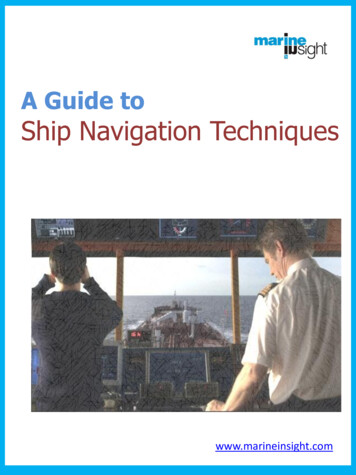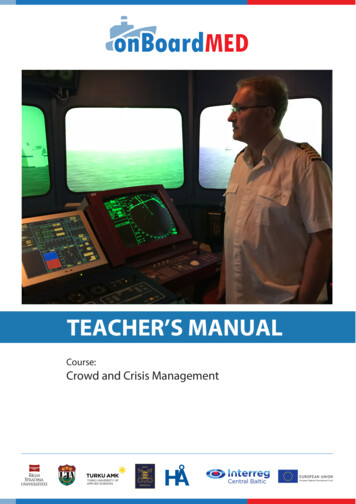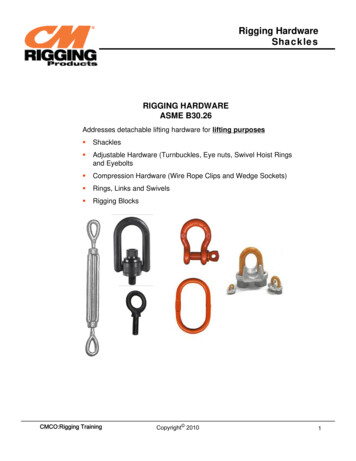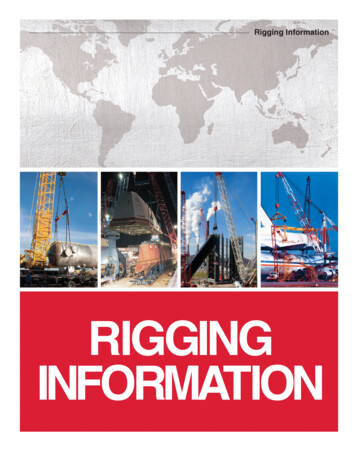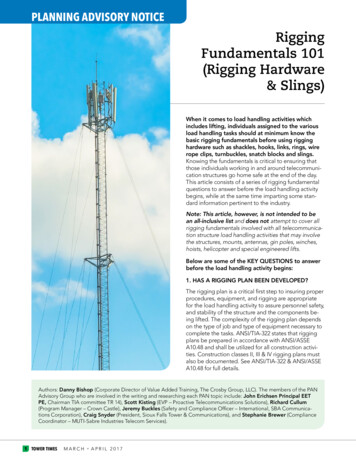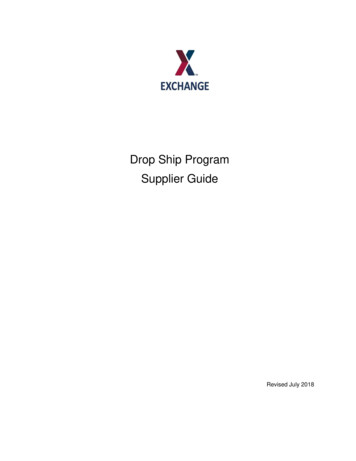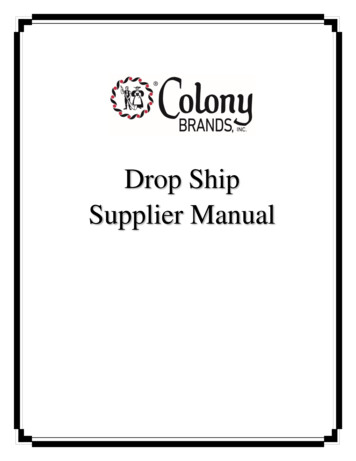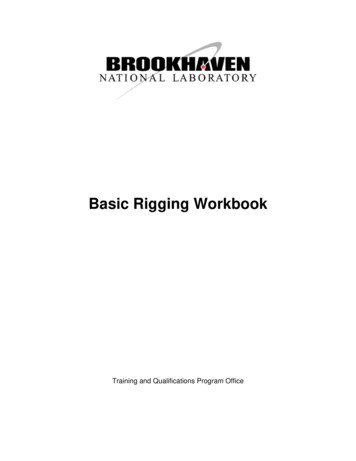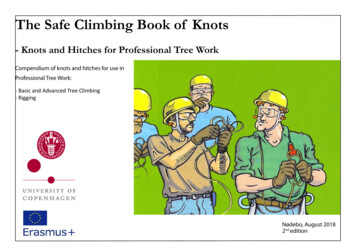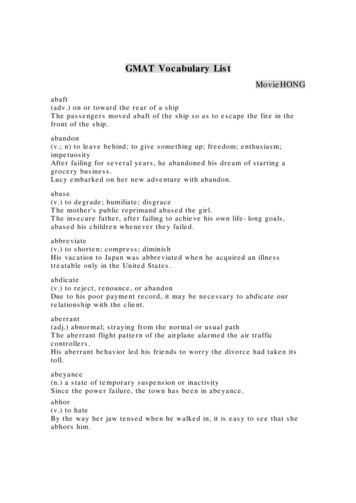
Transcription
Model Rigging Techniques
Preliminary Decisions Placement of Masts Angles of Masts Length of Main Mast – leads to length of all othermasts, yards, sizes of rigging line, block sizesand other items. Main mast length for the Sovereign of the Seaswas determined from Clive Millwards plans –based on the beam of the ship. Made other mast measurements based on CliveMillwards plans
Next determination if the thickness ordiameter of the Main Mast. By using thegeneral rule (stated by both Dr. Andersonand James Lee), which is that thediameter is 1 inch per 3 feet in length ofthe Main mast, thus it is 40 inches indiameter for the Sovereign of the Seas. This is basically rigging, so the diameter ofthe Main Mast determines the size of allthe lines in the rigging.
Basic Rigging details Standing RiggingRunning RiggingHawser-laid Rope (three strand)Shroud-laid Rope (four strand)Cable-laid Rope (Left hand twist)Size of line determined from Lees,Anderson, or can be calculated fromcontemporary sources.
Ships Plans Kit models usually come with riggingplans, but some are much better thanothers. The Corel kits seem to have goodplans from my experience. Other kits,such as the Sergal plans of Sovereign ofthe Seas are completely incorrect. For theSovereign, I used plans by Clive Millward,which were the best I could find, alongwith information from Lee’s book.
Gammoning A small eye-splice is made in one end and slipped overthe bowsprit at the proper location. The other end ispassed under the bowsprit from port to stbd. The turnsstart from aft on the bowsprit and forward in the slit forthe gammoning. Six or seven turns for each gammoningis sufficient. One more time up and over the bowsprit, bring the linehalf way down and make a half-hitch round the round theport half of the gammoning, take the end around the stbdhalf from forward aft and go on round outside everythingpulling the two sides closely together, wrap several moreturns and tighten the entire job. More difficult to try andexplain than to do.
Bobstays and Bowsprit shrouds Bobstays appeared about 1690 or1691. Bowsprit shrouds came in even later,probably around 1706. This brings up the detail you rig on yourmodel. Obviously, the Sovereign of theSeas would not have bobstays or bowspritshoruds.
Tackle Pendants The first item rigged on the lower foremast is the tackle pendants, if your shiphas them. The line used is the same asthe shrouds, which is usually hawser line(right line twist). The tackle pendants areserved their full length. You always startwith the starboard side first.
Showing the tacklependant, fully served,with tackle employed,which is unusual for aship model to show.
Picture of servingtechnique used toserve all the line.Technically, it iswormed, parceledand served, but theserving is all you cansee, so that is theonly thing that isdone.
Shrouds The next step is the shrouds, which areinstalled in pairs, the starboard side first.The foremost shroud is served its entirelength, as the sails chaffed the line. Allshrouds are served at the throat or thepart that goes over the mast. They goover the tackle pendants already served.Don’t forget the bolsters.
Deadeyes and Lanyards The shrouds go down to the deadeyes andare connected to the channels or the topas shown in the pictures. The deadeyesare joined by the lanyards. As a generalrule, the lanyards are ½ the thickness ofthe corresponding shroud and are righthand twist (Hawser) line.
Stays The stays lay atop the shrouds and are servedagain where they go over the top. The stays areleft hand twist (cable) laid line which has to bemade on a rope walk, as most purchased line isright hand twist. Later ships had preventer stays also, which werein addition to the regular stays. Stays were set up with blocks, deadeyes, orhearts, depending on the period and nationality.
Preventer stays This was introduced about 1700 accordingto Lees, and is therefore not installed onthe Sovereign of the Seas. I do not at thecurrent time have a ship model that hasthis rig. Almost a duplicate of the stay.
Rope Walk The rope walk is necessary due to the factthat left hand twist linen line is notavailable commercially. All the staysshould be left hand twist, which is madeup of three strands of right hand twistlinen. There are many variations of therope walk, some better than others. Mineis simple, but it works. Then there is thenew one which also works great.
Mouse The lower and topmast stays had mouse’sas part of the upper stay. A loop wasinstalled at the end of the stay, the staywas turned around the head of the mast,the other end of the stay was put throughthe loop, and a MOUSE was installed tokeep the stay from slipping through theloop.
Mouse Construction The Mouse can bemade the real way(see Anderson) ormade out of woodusing a small lathe,as I did, and stainedor painted black.
Garnet Tackle The garnet tackle is also part of thestanding rigging, although it could beconsidered running rigging also. Checkwith the proper authority to determine thecorrect tackle to use, since it varied bynationality and period. Used to hoistboats, guns, etc.
Futtock Shrouds First, the futtock staff has to be installed.This was sometimes served line. As ageneral rule, the futtock staff was about asfar below the top as the mastheadextended above it. The futtock shrouds were then installed,assuming that the lower deadeyes of thetopmast have been installed.
Special Stays Some of the more ornate ships,particularly the older ships, had veryornate stays. The Sovereign of the Seasexcelled in this area. The next slidepictures the bow area with the only“normal” stay being the lower one. All therest of the stays were highly ornate – therigger had a ball
Standing backstays Again, not on the Sovereign. Introducedaround 1670, they were in addition to theshrouds. You had standing backstays,breast backstays (few English ships werefitted with them), Running breastbackstays (introduced around 1733), andshifting backstays (usually not seen, asthey were only installed when additionalsupport was needed for an additional stayto the mast).
Backstays Although theSovereign of the Seasdid not havebackstays, later shipsdid. An example isthe model of the LeMirage, which is aFrench ship.
Catharpins Not all ships had catharpins, which wereupper and lower, usually on the fore andmain lower ratlines only. They are difficultto rig and not seen on many models. Youalso have to make sure that they arecontemporary with you particular shipmodel.
Ratlines Everyone’s favorite thing to install. Theratlines are installed using clove hitches.To be perfectly correct, they should besiezed at either end, but I use clovehitches throughout. When installing theratlines, I use drafting dividers to keep thespacing correct and a sewing needle toinstall the ratlines.
Crowsfeet This part of the standing rigging is not onthe Sovereign of the Seas, but is on my LeMirage. You have to make an Euphroe foreach installation, which is lashed to therespective stay. Again, you have to makesure that the proper rigging is installed foryour era of ship and nationality.
Running Rigging The second phase of the rigging processis the running rigging. This rigging isusually a light brown color as against theblack line of the standing rigging. Thereare two types of running rigging, thoselines controlling the yards (ties, halliards,jeers, lifts, braces, footropes and yardtackles) and tacks, sheets, bowlines, clewgarnets, buntlines and leechlines for thesails.
Seizing blocks The following views show the method Iuse to seize the blocks to the line. It looksvery neat and is essentially the way it wasreally done. This is one of the major usesof the “String-Along” devise. I plan oncutting a second one in half and extendingit to a longer length to make the seizing ofline easier.
Belaying devices The running rigging lines are all broughtdown to the deck or to the various tops inthe masts and belayed in some fashion.There were no belaying pins on theSovereign of the Seas, but shortly afterbelaying pins came into use. Kevels arealso in use. In some cases the line issimply tied or hitched off to the railing.
Tie, Halliard and Jeer The first order of running rigging is theinstallation of the yard. Prior to about1650 the Tie and Halliard were in use,after that date is was the Jeer (Englishships). This is one major area whereforethought must be involved wheninstalling. The Sovereign had both Jeersand tie and halliard, which is unusual.
Installation of Tie, Halliard, Jeer This varies from country to country. TheEnglish reeve the tie through sheavesinstalled on the side of the mast at the top,the French, Dutch and others run it overthe cap.
Parrels These are also installed at the same timeas the ties and halliards or jeers. This alsobrings us to the installation of many of theother lines. The blocks that these lines gothrough on the yards are best installedbefore the yards are installed.
Breast Rope This is a line that went around the parrelson the outside. This and the Navelinewere not installed on the Sovereign since Iwas not sure of the period of introduction.
Footropes and Stirrups There were almost no footropes on theSovereign of the Sea, certainly not in1637. However, around 1650 they startedto install them on English ships, so mySovereign has one only – on the mainyard (according to Lees). It is also best toinstall the footropes prior to installation ofthe yard on the mast.
Lifts Again, one has to be careful that the liftsare installed the correct way for the periodthe ship represents. The lifts on theSovereign of the Seas are different fromthe lifts on the French ship and changedaccording to Lees by period.
Jigger tackle This was used to assist the hoisting up ofthe yard by being seized to the lifts. Oncethe yard is lifted, it was removed. Notusually on models, but is mentioned insome of the rigging lists.
Braces The last lines installed on the ship whenrigging, since they will get in the way ofeverything else and are relatively easy toinstall at the end. Some variations arenoted, but not many. Mostly location onthe stays of the blocks.
Preventer brace Used only in wartime. Very seldom seenon models. Rig only if presenting themodel as rigged for battle.
Yard Tackle Introduced around 1685, they are againnot installed on the Sovereign. Another bitof rigging that can be installed on a ship ofa later period. An interesting bit of rigging,since it includes yard tackle falls and yardtackle tricing lines.
Martnets I did not install these on the Sovereignsince I did not have sails. If I had sails, Ithink I would have installed them. Theywere superseded by the leechlines, whichI did install.
Tacks, Sheets and Clue Garnets These are the next item of running riggingto install and pertain to the sails. Some ofthese blocks have already been installedon the yards. If you are installing sails,then the sails have to be installed prior torigging these lines. Otherwise, rigging cancontinue. Some individuals do not installthe sail rigging if sails are not installed.
The tack, sheet and clue garnet attachedto the lower corner of the fore and mainsails and control the “clew” or lower cornerof the sail. The tacks hauled the clewsdownward and forward, the sheets hauledthem downward and aft, and the clewgarnets (called simply clewlines on allother sails) hauled them up to the yards forfurling. Again, these lines ran in differentways according to country and time.Check your plans.
Topgallant clue & Sheet/lift The following group of slides show theinstallation of a typical topgallant clue andsheet/lift.
Bowlines Another sail line, used to hold the weatherleech of the sail up to the wind when closehauled or nearly so. Bowline bridlesactually attached the bowline to the sail.
Leechlines (Martnets) andBuntlines In reference to leechlines (or buntlines),these lines have to be researched beforeinstalling, as they varied by ship, periodand nationality. If you have good plans,go ahead and install. If not, research. Ifthis fails, leave the lines off. Lees is agreat source, as is Anderson. Buntlinesare not as complicated and are easilyinstalled.
These lines are very difficult to show onthe model by taking pictures, since thereare by this time many other lines which aregetting in the way. So, to make things alittle clearer, I took pictures of several ofthe drawings in Lees book – I hope he willforgive me.
Top Rope The upper yards are almost the same asthe lower ones, so most of the lines youhave already been introduced to. The oneline that is different is the Top Rope, whichis a line installed to lift the upper spars upso that they can be removed. Thetopmast top rope should be installed andhas to be done before the yard is installed,another example of forethought.
Extra tip When working toward the topgallant andthe royal yards, the line and blocks getsmaller and smaller. When I get down tothe 2.5mm and 2.0mm blocks, I can nolonger hold them in my hand to strop theblock. So, I use the helping hands.
Slab lines Designed to lift up the foot of the sail forclear visibility when sailing under a pilot,they are not on the Sovereign. Lee makesreference to them but does not specify anintroduction date.
Sails My personal preference with respect tosails – if the model is a four and aft rig,such as the Yacht Mary, then sails are agreat idea. If the model is a square sailrig, then sails are not such a good idea,since most of the rigging you do is hidden.Sails are made from drafting linen with abolt rope seized around the perimeter.You can spend a lot of time making sails.
Spritsail and Spritsail Topsail The spritsail topmast was adopted by theEnglish Navy in 1618 and abolished in1719, but this was official recognition. Thespritsail is the sail on the bowsprit, theyard being attached to the bowsprit by asling. The sails were basically the sameas the other yards with the exception of a“standing lift”, installed with deadeyes.
The spritsail also had additional bracescalled “Garnets”. All these lines areshown in both Lees and Anderson withexcellent descriptions of the lines. All the sizes of line and blocks requiredare listed in the back of Lee’s book“Masting and Rigging of English Ships ofWar”. Rigging was so common place backin the days of sail that no one made anycomment about it.
Spritsail Topsail This is one of the really fun things to rig. Itis simple once the standing rigging isdone, as the running rigging is just like thetopgallants.
Mizzen Lateen sail This is the last bit of running rigging that isdifferent but no difficult. This yard is a foreand aft yard with tie and halliard rigged alittle different. Full description again inboth Anderson and Lee.
Additional sail lines If installing sails, you also have additionallines to be installed. First, you have thereef points. These were braided andsecured to the sail by a knot on each sideof the sail. Obviously, you cannot installthese without the sails.
Reef tackles and pendants These were not carried on ships until theearly 19th Century. Not on any of the shipmodels I have built. Reef lines were used as a method ofreefing courses from 1719 to 1805replacing some of the reef points on thesail.
Earings Earings spread the upper corners of thesail out to the yard arm. Again, part of thesail.
Robands These were rope bands that fastened thehead of the sail to the yard or, in a laterperiod, to the jackstay.
Harbour gaskets Used to keep the sail furled. Betweeneight and twelve harbour gaskets wererequired for the sail, depending on the sizeof the sail There were also sea gaskets or furlinglines introduced in about 1650 which wereused at sea for furling the sail.
Model Rigging Techniques. Preliminary Decisions Placement of Masts Angles of Masts Length of Main Mast –leads to length of all other . made out of wood using a small lathe, as I did, and stained or painted bl
